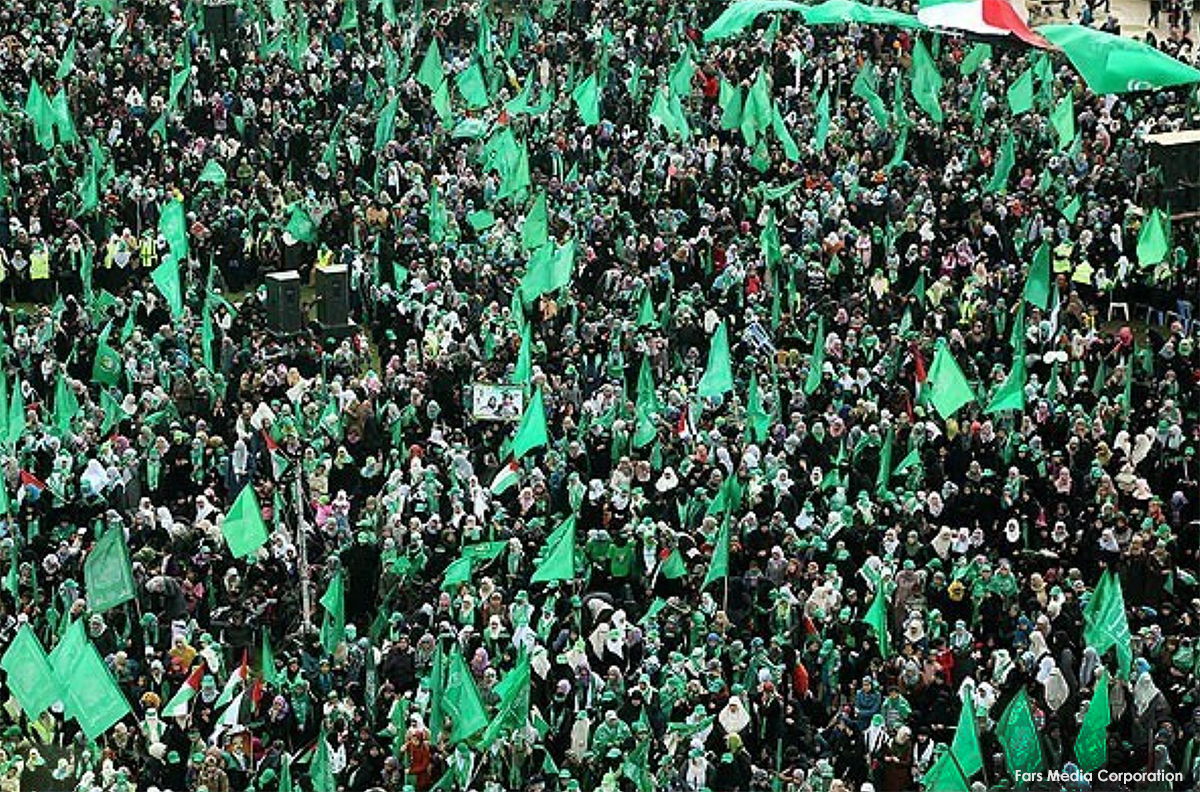Nearly a year after the October 7th, 2023 Hamas attacks on Israel, the UK has witnessed serious riots involving concerns around mass migration and crime. The government has responded with a severe crackdown, while pondering the “root causes” of the riots. The two events give us much to think about in the now nearly three-decades-long discussion surrounding Islamism, migration and multiculturalism.
For Western Europe, recent events are a harbinger of a perilous future. Indeed, there is a tendency to view these two issues—mass migration to Europe on the one hand, the Middle Eastern “conflict” on the other—as compartmentalized problems. In fact, the two are increasingly linked as a result of growing domestic Islamist political pressures and growing sympathy for the Islamist cause in the West, especially among those who profess a concern for social justice.[1] Since October 7th, we are beginning to see support for Islamism shape the foreign policy of Western countries in a direction that was difficult to imagine 20 years ago.
Both for the conflict in the Middle East and Western democracies, it would be useful to distinguish between Hamas the physical entity and Hamas the idea.
Hamas the physical entity possesses weaponry, tunnels, fighters, terrorists, foreign financial support and occasionally savvy public relations. All of these are potentially vulnerable to a determined opponent. With appropriate determination and strength, it should be possible to significantly weaken, perhaps even defeat, Hamas as a physical entity.
But what about Hamas the idea?
The extent to which the Islamist infrastructure has been established in Western countries in recent years, both in Western Europe and the United States, has now made “Hamas” a domestic issue in nearly every “Western” democracy, and no longer just a foreign policy one.
Hamas, as the political scientist Matthew Levitt reminds us, is “a Palestinian Islamist group that emerged in 1987 as an outgrowth of the Palestinian branch of the Egypt-based Muslim Brotherhood.” Indeed, Hamas was established with the goal “of eliminating the State of Israel and establishing in its place an Islamist state in all of what was once British Mandatory Palestine [comprising] Israel, the West Bank, and the Gaza Strip” (Levitt 2006, “Origins of the Hamas Dawa”). The centrality of violent jihad was duly enshrined in Article 8 of Hamas’s charter.
Beyond eliminating Israel, Hamas from an early stage viewed itself as being part of something bigger and greater, “the spearhead of a national project, which has Arab, Islamic and international ambitions as well” (Ibid.) Hamas, like its originator the Muslim Brotherhood, is indeed “Islamist”. But what does this mean?
Islamism bases itself on one particular aspect of Islam’s formative period.
In the early years of Islam, there was an initial period where the Prophet Muhammad resided in Mecca and revealed more spiritual and ascetic Qur’anic verses. The subsequent more political and militaristic phase occurred when the Prophet Muhammad resided in Medina.
Those people we call “Islamists” hearken back to this latter period when early Islam set a political and militaristic agenda as its central mission in Medina invoking Qur’anic verses revealed during this period. (Under the prevailing Islamic doctrine of abrogation, Qur’anic verses revealed later take precedence over verses revealed earlier.). Ordinary Muslims who seek spiritual guidance and fulfillment in Islam tend to refer to Muhammad’s message in Mecca. Either they downplay or ignore the Muhammad of Medina and those parts of the Quran that make for uncomfortable reading.
Islamists do the opposite. They insist that Islam’s central mission is to transform the world by all means necessary into an Islamic State or states closely following Muhammad’s blueprint in Medina: that is through ‘hijra’ or immigration or settlement, through the building of a military base and through dawa or ‘invitation’ or ‘call’ to Islam followed by increasingly more forceful measures, possibly including violence as circumstances warrant.
The concerns that Western humanists and reformers have with “Islamism” and “Islamists” stem from the treatment of women, religious and sexual minorities, non-Muslims, relationship with the outside (non-Islamic) world, the rules governing militant jihad and the enslavement of others, and the like. In its current form, Shariah law—generally favored by Islamists—is incompatible with modern understandings of human rights, particularly provisions regarding freedom of conscience, religion, and the status of the legal testimony of women. Many—not all, but many—of these concerns stem from the Medina period.
When Islamism is therefore often described as somehow beginning with various “revivalist” thinkers in the late 19th and early 20th centuries, that is, as a “modern” phenomenon, I do quibble. Although I do not dispute the intellectual and historical importance of figures such as Rashid Rida and Hasan al-Banna, the real root of “Islamism” or political Islam is not to be found in the late 19th and early 20th century strictly speaking but rather in the Medina period many centuries ago.
Accordingly, those Muslims we call “reformist” Muslims have either sought to reverse the prevailing doctrine of Qur’anic abrogation so as to give precedence to the Mecca period or properly contextualize the Medina period , or have sought to re-interpret the “Medina” period and political governance in Islam in much more fundamental ways. Courageous voices continue this effort to this day in various ways.
Nevertheless, in purely organizational terms the group that built on “political Islam” in the 20th century perhaps most (in)famously is the Muslim Brotherhood, a “modern” organization. Today, the Brotherhood has numerous offshoots, of which Hamas is merely one. It is indeed true that the Brotherhood is far from alone in the Islamist constellation, both in the West and elsewhere, as analyst Sam Westrop has observed, with groups such as the Deobandi movement, Jamaat-e-Islami and Tablighi Jamaat—and others— all playing important roles in spreading global Islamism. Nevertheless, the Muslim Brotherhood retains our attention due to its ever growing establishment in the West, its intellectual and organizational effectiveness, its diffusion, and its numerous offshoots over time.
The ideological links, the connections, that exist between Hamas the idea and the Muslim Brotherhood as an intellectual organization and movement make it unwise to focus only on tackling Hamas as a physical entity. If Hamas the idea is not addressed and left to subsist, the effective Islamist infrastructure—particularly in Western countries—will ensure that some other version of Hamas rises again. Such entities already exist in the West as religious, cultural, intellectual, philanthropic, financial and economic hubs. For now all that is missing is a military arm like Hamas.
The Islamist infrastructure in “the West”, including the Hamas network, is strong. The Brotherhood was frequently repressed by governments in the Arab world, where governments understood its goals well. In contrast, in Western countries Islamist groups including those linked to the Brotherhood have often found a fairly welcoming atmosphere. Islamists have keenly exploited the search of governments for “representative” and well-organized, ostensibly non-violent intermediaries. In presenting themselves as a “non-violent” alternative to groups such as Al-Qaeda, those linked to the Brotherhood and other Islamist groups have led many Western governments and analysts astray. In claiming to speak for all Muslims living in the West, in their fondness for organizing and organization, in their ability to channel funds, Islamists including the Brotherhood have successfully built a formidable infrastructure.
Sober analyses of this can be found in two recent books: the Yemeni-Swiss political scientist Elham Manea’s The Perils of Nonviolent Islamism and French anthropologist Florence Bergeaud-Blackler’s book Le Frérisme et ses réseaux (“Brotherism and its networks”). These books are lucid and clear-eyed but are nonetheless committed to what one might call a “humanist” defense of key principles of Western civilization. Universities, political parties, media entities, local councils, civil society organizations and NGOs—all of these have been successfully infiltrated or are under growing pressure from Islamists or those who are in some way sympathetic to them and their goals. In addition to exploiting the existing political, cultural, educational and media institutions of the West, Islamists of various stripes have built a competing infrastructure of schools, universities, online media and are in some countries considering founding political parties or have already founded such parties. All this is possible due to the growing demographic of Muslims because of higher birth rates, high immigration and very successful dawa (Islamization) efforts.
In the United States, the widely viewed footage of college demonstrations and encampments featuring pro-Hamas slogans outraged important segments of public opinion. In an unusual move, a number of U.S. law firms expressed concern over anti-Semitic expressions by future employees in the framework of Hamas’s attacks on Israel. Some university alumni and donors similarly expressed dismay at how sensitive issues have been handled, particularly at America’s most prestigious “Ivy League” universities.
But the problem is not really one of college encampments and occasionally violent confrontations. Although such demonstrations were perhaps the most publicly visible manifestation of support for Hamas, they are in my mind not the most worrisome. Rather, what disturbs me is the fairly large pillar of support enjoyed by Hamas in certain parts of public opinion in Western democracies because of what it portends for the future.
This support is increasingly weighing on left-of-center political parties and tilting them, both in the U.S. and in Europe. One survey of 609 randomly selected current 4-year American college students found that in the Hamas/Israeli conflict, “22% of students say they sympathize with Hamas, while 26% say they sympathize with the Israeli government”, an astonishing figure given that Hamas is a terrorist organization. Just as worrisome, 40% of the surveyed students say they sympathize with Hamas either a lot (17%) or a little (24%), while 33% say they don’t at all, and 27% are unsure. The anti-Israel protests at the Democratic Convention in Chicago have, at their core, radical groups that are openly hostile to Israel while proclaiming support for social justice. The “Uncommitted” movement has influence that should not be dismissed among the many young activists whose support is sought by the Democratic Party on the ground and in hotly contested States.
In the United Kingdom, a survey commissioned by the Henry Jackson Society found that “almost half of British Muslims feel more sympathy with Hamas than Israel”. Remarkably, only 24% of British Muslims surveyed stated they have a negative view of Hamas. A fairly wide gap between British Muslims and members of the general public now exists on issues related to Israel and Islamism. In a sign of progressive excess, former Labour leader Jeremy Corbyn has “repeatedly refused to call Hamas a terrorist organization”, leading to repeated denunciations by Prime Minister Keir Starmer.
One can say that Islamist intellectual and ideational infrastructure is by now fairly well-entrenched in the West, even if the layman—particularly in the U.S.— is generally not aware of this phenomenon. Hamas the idea, in turn, is merely one facet of a broader infrastructure.
My concern is that, to the extent Western governments support taking measures against Hamas as a physically existing institution, Hamas the idea (which is indeed the exact same idea that animated Al-Qaeda and ISIS) risks being overlooked because it appears less tangible, less acute, more diffuse, and less immediately relevant.
In a similar vein, after the 9/11 attacks, the U.S. and other Western countries vigorously pursued those who engaged in terror, but were deeply ambivalent about how best to approach the war of ideas, which had lasting consequences.
As we now know, when Al-Qaeda in Iraq was degraded and dismantled, ISIS emerged. And even though ISIS was removed from Iraq and Syria, ISIS-K emerged from 2015 onwards out of former members of the Pakistan and Afghan Taliban. ISIS-K is a potent terrorist force that among other things seeks to carry out large scale terror activities in the U.S. A plot to blow up a Taylor Swift concert was recently foiled in Austria; authorities found Islamic State group and al Qaeda material at the home of the second suspect. It is important to mention in this case that even though the plot was foiled the event was canceled!
Were Israel to succeed in degrading, dismantling and destroying the Hamas tunnels, military and other hardware—and I hope with all my heart she does—what remains is Hamas the software. That software lives on in the Muslim Brotherhood and its associated groups.
Support for Hamas among college students is therefore not a sudden phenomenon: it has been “in the works” for a while. It is part of broader support for Islamist movements in the world as representing the other, the oppressed, the marginalized, the victim, against the oppressor—the oppressor here being “white” Western civilization in general. Israel and Jews more broadly are viewed as being part of a dominant, oppressive superstructure of whiteness that needs to be taken down a few pegs.
Support for Islamist movements in the name of social justice is radical, as many reformist Muslims warn us. Islamist movements are themselves both oppressive and repressive, in terms of their effects on internal minorities and dissidents. Wherever Islamist movements come to power, human suffering increases greatly.
Through sympathy with Islamism more broadly, “Hamas the idea” has therefore found fertile ground not only on U.S. campuses—as Americans have recently seen— but also in many European cities, where Islamism will continue to enjoy a fairly cozy and hospitable physical, financial and intellectual environment, compared to much of the Arab world.
The foreign policy of many European countries and even the U.S. will increasingly be shaped by growing support for Islamism, and by extension Hamas, among a certain share of the population. Whether this population is either Islamist, or non-Islamist but committed to a particular interpretation of “social justice” that valorizes Hamas, is less relevant than the effect of this support.
For Hamas to be defeated, it will therefore not be sufficient for Hamas to be physically declawed. Driven by the same ideas, a similar group will simply arise, motivated by similar ideas, much like heads of a hydra can reappear and continue the fight.
An earnest engagement with the principles and objectives of the Muslim Brotherhood and Hamas is required among Western intellectuals, humanitarians and representatives of civil society. My Hoover colleague Russell Berman has argued, on a more optimistic note, that it is possible to “defeat” harmful totalitarian ideas over time with sustained effort. I hope that this will be the case. In the meantime, both in foreign and domestic policies of Western democracies, it will be necessary to grapple not only with Hamas the physical entity but also with Hamas the idea.
[1] Countries such as Sweden, whose government has shifted towards a more “pro-Israel” approach since October 7th, remain the exception to the rule.

















